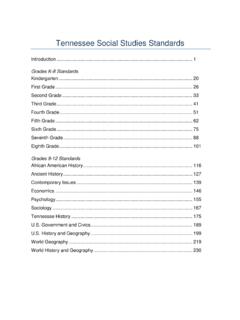Transcription of Deterministic vs. Stochastic Models
1 Stochastic Models !September 7, 2011!1!CPIB SUMMER SCHOOL 2012: INTRODUCTION TO BIOLOGICAL MODELLING"Nick Monk!Lecture Stochastic Models "1! Deterministic vs. Stochastic Models ! Deterministic Models (differential equations):! the state is represented by continuous variables,! reactions/interactions are represented as continuous processes (production, decay, movement,..).!This is appropriate when the numbers of each species and the frequency of reaction events are sufficiently large .!This is not always the case." transcription (1 or 2 copies of each gene); mRNA-protein networks in prokaryotes; low-density populations, ..!2!Reaction Rates vs. Events!In Deterministic Models (differential equations) each process ( transcription, degradation) has a rate (which is typically a function of the state).! Rate of transcription = !
2 !This gives a measure of how frequently each type of reaction is expected to occur (for a given state).!Alternatively, we can develop Models centred on individual reaction events ( the production of a single mRNA molecule, or the binding of two protein molecules).! ATF[]h+TF[]3! Stochastic Models !September 7, 2011!2!Reaction Rates vs. Events!In a typical biological system, reaction events do not occur at regular intervals.! in a well-mixed solution, molecular motion can be represented as Brownian motion; bimolecular reactions occur when two reactant molecules approach closely enough (and in the correct orientation). ! transcription depends on the assembly of a polymerase complex and then sequential addition of nucleotides.!The timing of these events is essentially Stochastic rather than Deterministic .!4! Deterministic "Stochasti c"Ordinary differential equations!
3 Continuous time Markov chains!Concentrations of molecules!Numbers of molecules!Future is predictable given present knowledge!Includes randomness; every simulation is different!Wide range of techniques available for analysis!Not as many techniques for analysis; often rely on simulations!Good for large number of individuals; qualitative analysis!Better for simulating dynamics with small numbers of molecules!Represents population average!Represents population variability! Deterministic vs. Stochastic Models !5! Stochastic kinetics! Assume homogeneity:! P(molecule in volume V) is equal for each V on the timescale of the chemical reactions that change the state.! In other words, we assume that the reaction mixture ( the inside of the cell) is well-mixed. This may be questionable.! Then the state of a cell can be represented by a vector n, where!
4 !!!and ni is the (integer) number of molecules of species i in the cell (i = 1, 2,.., N). Note that we could equally well use concentrations rather than numbers.! n=n1,n2,..nN[],6! Stochastic Models !September 7, 2011!3!The stoichiometric matrix! Elementary reaction j changes the state:!!where ij is the stoichiometric matrix. ! The state vector n changes by j (the state change vector) when reaction j occurs:!! Note that the elements of the state change vector are integers ( ij is just the change in the number of molecules of type i when reaction j occurs). !! n n+ j, j= 1j, 2j,.. Nj(). ni ni+ ij,7!The stoichiometric matrix!For example, consider transcription of a gene, translation of the mRNA, reversible dimerisation of the resulting protein, and degradation of each species.!State: n = [M, P, D] = [mRNA, protein, dimer]!
5 M1. Transcription:!2. Translation:!3. Dimerisation:!4. Dissociation:!5. M degradation:!6. P degradation:!7. D degradation:! P P+P D D P+P M P D Reactions:! !State change vectors:! ! 1=1,0,0[] 2=0,1,0[] 3=0, 2,1[] 4=0,2, 1[] 5= 1,0,0[] 6=0, 1,0[] 7=0,0, 1[]8!The Master Equation! Let the rate of reaction j be rj(n). !!In other words, the probability that reaction j occurs in a small time interval t is rj(n) t.! Note that this probability depends on the network state.! Note also that it is assumed that the reaction occurs instantaneously.! Let P(n,t) be the probability that that the network is in state n at time t. The master equation describes how this probability changes in time, given a set of elementary reactions.!9! Stochastic Models !September 7, 2011!4!The Master Equation! Parrive = Prob.
6 That network arrives in state n in time [t, t+ t].! Pleave = Prob. that network leaves state n in time [t, t+ t].! Pstay = Prob. that network stays in state n in time [t, t+ t].! Parrive= trjj=1M n j()Pn j,t(),Pleave= trjj=1M n()Pn,t(),Pstay=1 trjj=1M n()& ' ( ( ) * + + Pn,t().10!The Master Equation! Pn,t+ t()=Pstay+Parrive =1 trjj=1M n()% & ' ' ( ) * * Pn,t()+ trjj=1M n j()Pn j,t() Pn,t+ t() Pn,t()= trjn j()Pn j() rjn()Pn()[]j=1M .In the limit t 0, we get ! dPn,t()dt=rjn j()Pn j() rjn()Pn()[]j=1M .11!Simulating paths of the Master Equation! The master equation encodes a continuous time, discrete state Markov process. ! The master equation is hard to solve, so often rely on simulating paths ( Stochastic realisations of the evolution of the state via elementary reactions that occur with probabilities in accordance with the master equation).)
7 ! First determine the probabilities of reactions occurring.! Determine from this the next reaction time (drawn from an exponential distribution).! Choose the reaction type to implement, according to fractional rates.!12! Stochastic Models !September 7, 2011!5!Simulating paths of the Master Equation! Prob that some reaction will occur in time t = ! trjn()j=1M Let p(t) = prob that the system has not left state n at time t given that it was at n at t = 0.! Then! pt+ t() pt()= r0pt() t In the limit:! dpdt= r0pt() p(t)=exp r0t(). Prob that a reaction has occurred at time t is! F(t)=1 p(t)=1 exp r0t().13!The Stochastic simulation algorithm (SSA)! Prob that a reaction has occurred at time t is! F(t)=1 p(t)=1 exp r0t(). Therefore, the system residence time in state n ( the time to the next reaction) is exponentially distributed with average = 1/r0.
8 ! The probability that the first reaction to occur is of type j is its relative contribution to the total rate, rj(n)/r0.! Algorithm (Doob, 1945; Gillespie, 1976,77):! Pick the next reaction time from an exponential distribution,! Choose a reaction type according to the fractional rates.!14!The Stochastic simulation algorithm (SSA)! Algorithm (Doob, 1945; Gillespie, 1976,77):! Pick the next reaction time from an exponential distribution,! Choose a reaction type according to the fractional rates.! In practice:! Draw two random numbers s1 and s2 from the uniform distribution in the unit interval.! Reaction time = ! Reaction type j is the smallest integer such that! 1r0(n)ln1s1" # $ % & ' r" j " j =1j n()>s2r0n().15! Stochastic Models !September 7, 2011!6!1. Specify reaction stoichiometry (state update vectors j), reaction propensities and simulation time.
9 !2. Specify initial state n = n0 and time t = t0.!3. Calculate the sum of all reaction propensities [= r0(n)].!4. Generate two random numbers s1 and s2 from the uniform distribution in the unit interval.! Time to next reaction! Reaction type j is the smallest integer such that!5. Update time t t + . "6. Update state n n + j according to reaction j.!7. Recalculate propensities.!8. Go to 3. ! =1r0(n)ln1s1# $ % & ' ( r" j " j =1j n()>s2r0n().The Stochastic simulation algorithm (SSA)!16! A constitutively expressed protein! Two types of reaction:!Protein synthesis (constant rate)!Protein degradation !k Simple Example! dPdt=k PODE model :"Parameters:! k = 1 Ms-1! = 1/1800 s-1! P0 = 0!17! Parameters:! k = 1 s-1! = s-1! P0 = 0! Random fluctuations in numbers of molecules! Stochastic Simulation!18!)
10 Stochastic Models !September 7, 2011!7! Two simulations show different time courses because of stochasticity! Statistical properties are the same! Average of many Stochastic simulations can look like the Deterministic model !02004006008001000020406080100 Time / sProtein AbundanceEach Simulation Run is Different!19! Both Models have same mean and rise to that mean! Stochastic model includes fluctuations about mean! In this case, the mean is as given by the Deterministic model !Comparison to Deterministic Simulation!20!02004006008001000020406080 100 Time / sProtein AbundanceTransient!Equilibrium distribution:!Defined by statistical properties!Equilibrium Distribution! Noise associated with protein synthesis is (approximately) Poisson! Key property: variance of equilibrium distribution is proportional to mean!21! Stochastic Models !







![arXiv:1901.02860v3 [cs.LG] 2 Jun 2019](/cache/preview/b/9/c/2/9/2/3/4/thumb-b9c292342bb76a16efe67e4fbea33de9.jpg)
